Pecan Upside Down Cake is a delightful, show-stopping dessert that combines the warm, nutty flavor of pecans with the sweetness of caramelized brown sugar, all beautifully layered on top of a soft and moist cake. The cake’s design ensures that the pecan topping becomes the visual centerpiece once inverted, making it not just delicious but also visually appealing. The simplicity of this recipe, which utilizes a store-bought cake mix, means it’s easy to prepare while still delivering a decadent and impressive dessert.
History of Upside-Down Cakes and Their Evolution into Modern Recipes
Upside-down cakes have a long and varied history, tracing their roots back to early skillet cakes made over an open fire. In these early versions, fruit, sugar, and butter would be placed at the bottom of a pan with cake batter poured on top. After baking, the cake was flipped over to reveal a glossy, caramelized fruit topping. One of the most famous variations, the Pineapple Upside Down Cake, rose to popularity in the early 20th century, driven by canned pineapple’s availability. Over time, creative bakers expanded beyond pineapple, experimenting with other fruits, nuts, and flavor combinations. Pecan Upside Down Cake is one such evolution, showcasing a rich, nutty variation of this classic dessert tradition.
Why This Cake is a Perfect Dessert Option for Holidays or Family Gatherings
Pecan Upside Down Cake is an ideal choice for holidays and family gatherings for several reasons. First, its rich, buttery pecan topping and moist cake make it a comforting, indulgent dessert that pairs well with seasonal flavors, particularly during the fall and winter months. Second, the cake’s striking appearance – with caramelized pecans glistening on top – adds a touch of elegance and festive appeal, perfect for special occasions. Lastly, the recipe’s simplicity and use of a cake mix make it accessible for home bakers, even those with limited time or experience. It’s a dessert that looks and tastes like you spent hours preparing it, yet comes together with ease, making it a crowd-pleaser at any gathering.
What Makes This Recipe Special
Highlight the Rich, Buttery Pecan Topping
The highlight of any pecan upside-down cake is undoubtedly the topping. The combination of melted butter and brown sugar creates a caramel sauce that coats the pecans, giving them a glossy, candy-like finish once the cake is inverted. This rich, buttery topping contrasts beautifully with the soft cake beneath, adding not just flavor but a delightful crunch to each bite. The pecans themselves add an earthy, slightly sweet nuttiness that elevates the dessert’s flavor profile, making each mouthful a balance of sweet and savory.
The Combination of Cake Mix and Vanilla Pudding for an Easy Yet Delicious Cake Base
One of the key features that makes this particular pecan upside-down cake recipe stand out is its use of a yellow cake mix combined with instant vanilla pudding mix. This combination guarantees a soft, moist, and flavorful cake with minimal effort. The pudding mix helps to enrich the cake’s texture, ensuring it stays moist and fluffy throughout the baking process, while the cake mix streamlines the preparation, allowing bakers to focus on perfecting the pecan topping. Despite its simplicity, this combination yields a cake that tastes homemade, with layers of flavor that complement the pecan topping perfectly.
Texture Contrast Between the Soft Cake and the Crunchy Pecans
Texture plays a significant role in the appeal of this cake. The contrast between the soft, spongy cake and the crunchy, caramelized pecans creates a satisfying bite. The cake itself, light and tender, serves as the perfect canvas for the topping, which delivers a sweet, buttery crunch with every mouthful. This contrast is not just pleasant on the palate but also adds to the overall indulgence of the dessert, making it more dynamic and enjoyable to eat. Whether served warm or at room temperature, the interplay of textures is what makes this cake truly memorable.
Ingredients Breakdown
Yellow Cake Mix
Using a yellow cake mix as the base for this recipe offers both convenience and reliability. The mix provides a consistently moist and flavorful cake without requiring the extra effort of making a batter from scratch. Yellow cake is particularly well-suited for this recipe because of its buttery, vanilla flavor, which pairs beautifully with the rich, caramelized pecans.
Tips for Choosing the Right Brand and Alternatives:
When selecting a cake mix, look for options with high-quality ingredients and natural flavors. Brands that incorporate real butter flavor or have less artificial additives tend to produce a better-tasting cake. For those who prefer a homemade approach, you can easily create a substitute by mixing flour, sugar, baking powder, and butter to form your own yellow cake base.
Instant Vanilla Pudding Mix
The addition of instant vanilla pudding mix enhances the cake’s moisture and texture, ensuring that the cake remains soft and tender even after baking. The pudding mix acts as a thickening agent that helps bind the ingredients, leading to a denser yet moist crumb that balances the crunch of the pecan topping.
Possible Substitutes:
If you don’t have instant pudding mix on hand, you can make a simple homemade pudding mix using cornstarch, sugar, and vanilla extract. Other flavors like butterscotch or chocolate pudding could be used to add a unique twist to the recipe, although vanilla is the most neutral option.
Eggs, Vegetable Oil, and Water
These standard cake ingredients serve vital functions in the recipe. The eggs provide structure and richness, while the vegetable oil adds moisture, ensuring the cake doesn’t dry out during baking. Water helps to combine all the ingredients smoothly.
Possible Alternatives:
For a healthier version, you can substitute olive oil for vegetable oil, though it may slightly alter the flavor. To make the recipe vegan, flax eggs (a mixture of ground flaxseed and water) can replace the eggs, and almond milk or other plant-based milk can substitute for water.
Butter and Brown Sugar
The butter and brown sugar together create the luscious caramelized topping that coats the pecans and gives the cake its signature flavor. When melted in the pan, the butter and sugar mixture transforms into a caramel-like sauce that provides the glossy, sweet finish on top of the pecans.
Differences Between Light and Dark Brown Sugar:
Light brown sugar adds a milder caramel flavor, while dark brown sugar has a more intense molasses content, creating a deeper, richer taste. Either can be used depending on your flavor preference.
Importance of Butter Quality:
High-quality butter, preferably unsalted and with a rich creaminess, enhances the overall flavor of the topping. Using European-style butter with a higher fat content will provide an even richer result.
Pecan Halves
Using whole pecan halves rather than chopped pieces allows for a more visually appealing presentation when the cake is inverted. The halves create a beautiful top layer that shows off the glistening, caramelized nuts.
Roasting or Toasting Pecans for Extra Flavor:
For an even more intense flavor, consider roasting or toasting the pecans before assembling the cake. This step enhances their natural nutty flavor and brings out additional depth.
Nutritional Benefits of Pecans:
Pecans are a rich source of healthy fats, fiber, and protein. They also contain vitamins and minerals like manganese, copper, and zinc, which contribute to overall wellness.
Step-by-Step Instructions
Preparation
- Importance of Preheating the Oven
Preheating the oven to 350°F (175°C) is crucial for ensuring that your cake bakes evenly from the start. An oven that’s not fully preheated can result in an uneven rise, where the edges bake before the center. This can lead to a dense, unevenly cooked cake. Allow your oven to reach the desired temperature before placing your cake inside. - Preparing the Baking Pan
Properly greasing the pan is essential to prevent the cake from sticking, especially since this is an upside-down cake with a sticky caramelized topping. Spray your bundt or square pan with a nonstick baking spray that includes flour, or alternatively, you can grease the pan with butter and dust it with flour. If you’re using a square or round pan, consider lining the bottom with parchment paper for extra assurance when inverting the cake later.
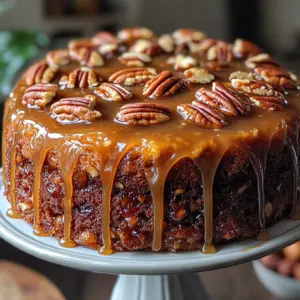
Mixing the Cake Batter
- Achieving a Smooth, Lump-Free Batter
To ensure a smooth batter, it’s essential to sift your cake mix before using it, which helps prevent clumps. When combining the cake mix with the pudding mix, eggs, vegetable oil, and water, start by mixing the dry ingredients first. Then, gradually add the wet ingredients while beating the mixture at a low speed, which will prevent overmixing and keep the batter smooth and light. - Best Practices for Beating the Ingredients Together
Using an electric mixer, beat the eggs, oil, and water with the dry ingredients for about 2-3 minutes on medium speed. This not only combines the ingredients but also incorporates air, helping the cake become light and fluffy. Be sure not to overbeat, as this can lead to a dense cake. The batter should be smooth and thick, with no visible lumps.
Creating the Pecan Layer
- Pouring the Melted Butter and Sprinkling Brown Sugar
Begin by melting 1 stick (1/2 cup) of butter and pouring it evenly into the prepared pan. Make sure the butter spreads across the entire bottom to ensure uniform caramelization. Sprinkle the brown sugar evenly over the melted butter, covering the entire surface for an even caramel topping that will coat the pecans. - Arranging the Pecans
Next, arrange the pecan halves in the pan on top of the brown sugar. To create a decorative pattern, start by placing pecan halves in concentric circles if using a bundt pan, or neatly aligning them if using a square pan. Ensure the pecans are evenly distributed and not overlapping too much, as this ensures a beautiful, uniform top once the cake is inverted.
Assembling the Cake
- Pouring the Batter Over the Pecan Layer
Once the pecan layer is in place, carefully pour the cake batter over it. To avoid disturbing the pecans, pour slowly and evenly, starting from the center and moving outward. This will help keep the arrangement intact. - Spreading the Batter Evenly
Use a spatula to gently spread the batter so it covers the pecans and is evenly distributed across the pan. A smooth batter ensures the cake will bake evenly and rise properly.
Baking the Cake
- Adjusting Baking Time for Different Pans
The type of pan you use will affect baking time. For a bundt pan, bake for about 45 minutes, while a square or round pan will require a shorter baking time of around 35 minutes. Keep an eye on the cake as it bakes, especially if you’re using a dark-colored pan, as these tend to heat faster. - Testing for Doneness
To check if the cake is done, insert a toothpick or cake tester into the center of the cake. If it comes out clean or with a few moist crumbs, the cake is ready. If the toothpick comes out with wet batter, bake for an additional 5 minutes and test again.
Cooling and Inverting
- Cooling the Cake Slightly Before Inverting
Once the cake is baked, allow it to cool in the pan for 10-15 minutes. This cooling period is crucial because if you invert the cake too early, the topping may not have set enough, and the cake could fall apart. However, waiting too long can cause the caramel to harden, making it difficult to release from the pan. - Steps for Inverting the Cake
Place a serving plate over the top of the cake pan. Using oven mitts, carefully flip the pan over while holding the plate firmly in place. Gently lift the pan off the cake. If some pecans stick to the bottom of the pan, use a spatula to lift them and place them back on top of the cake.
Troubleshooting:
If the cake resists coming out of the pan, you can gently tap the bottom of the pan to help release it. For stubborn cakes, placing a warm, damp towel on the inverted pan for a few minutes can help loosen the caramelized topping, making it easier to remove.
Serving Suggestions and Variations
Serving Tips
- Presenting the Cake for Maximum Visual Appeal
To showcase the beauty of the caramelized pecan topping, place the cake on a decorative cake stand or a large, flat serving plate. When inverting the cake, ensure that the pecans remain intact and shiny on top. If necessary, rearrange any pecans that may have shifted. For an added touch, you can lightly dust the edges of the plate with powdered sugar or place some whole pecans around the cake for garnish. - Ideal Pairings
Pecan Upside Down Cake pairs wonderfully with light accompaniments that balance its rich flavors. A dollop of freshly whipped cream or a scoop of vanilla ice cream complements the buttery, nutty topping and moist cake. If you prefer a more indulgent option, consider serving the cake with a drizzle of warm caramel sauce or a flavored whipped cream, such as cinnamon or bourbon-infused cream, to elevate the flavors even further.
Flavor Variations
- Altering the Cake Base
While this recipe traditionally uses a yellow cake mix, there are numerous ways to experiment with flavors:- Chocolate Cake Mix: For a richer flavor, substitute the yellow cake mix with a chocolate cake mix. The bittersweet chocolate pairs well with the caramelized pecans, creating a decadent twist.
- Cinnamon or Spices: Adding 1 to 2 teaspoons of cinnamon, nutmeg, or allspice to the batter brings a warm, spicy depth to the cake that complements the sweetness of the pecans.
- Different Nuts: Swap out the pecans for walnuts, almonds, or hazelnuts to create new flavor profiles. Each nut offers a different texture and taste, allowing for unique variations of the cake.
- Alternative Toppings
For those looking to experiment with the topping, consider adding dried fruits such as raisins, cranberries, or chopped dates to the brown sugar and butter mixture for a chewy, sweet contrast. You could also drizzle a caramel or chocolate sauce over the cake after inverting it, which adds another layer of flavor and richness.
Healthier Options
- Reducing Sugar Content
If you’re looking to reduce the sugar content, consider using coconut sugar or a natural sugar substitute like monk fruit sweetener instead of brown sugar in the topping. Coconut sugar offers a more subtle sweetness and a lower glycemic index while retaining the caramel-like flavor that complements the pecans. - Gluten-Free Version
For those with gluten sensitivities, you can easily adapt the recipe by using a gluten-free yellow cake mix. There are many high-quality gluten-free mixes available that will still provide the same light and moist texture. Ensure that your pudding mix and other ingredients are also gluten-free to maintain consistency. - Dairy-Free and Vegan Adjustments
To make the cake dairy-free, substitute the butter in the topping with a plant-based alternative, such as vegan butter or coconut oil. For a vegan version, replace the eggs with flax eggs (1 tablespoon of ground flaxseed mixed with 3 tablespoons of water for each egg) and use a dairy-free cake mix and pudding mix. You can also use plant-based milk, such as almond or oat milk, instead of water in the batter to enhance moisture.
Tips and Tricks for a Perfect Pecan Upside Down Cake
Common Mistakes and How to Avoid Them
- Troubleshooting Cake Sticking to the Pan
One of the most common issues with upside-down cakes is getting them to release from the pan cleanly. To avoid this, make sure you thoroughly grease the pan with nonstick spray, butter, or a combination of butter and flour. Using parchment paper at the bottom can also provide extra insurance. After baking, allow the cake to cool for 10-15 minutes before inverting, as this helps the caramel topping set without sticking. - Preventing Over-Browning of the Pecans
Over-browning can occur if the pecans are exposed to too much direct heat. To prevent this, check the cake halfway through baking and, if necessary, cover it loosely with aluminum foil. This will shield the pecans from burning while allowing the cake to finish baking. - Ensuring the Cake Doesn’t Turn Out Too Dry or Dense
A dry or dense cake is usually the result of overmixing or overbaking. Mix the batter only until the ingredients are just combined to avoid developing too much gluten, which leads to a denser texture. For moisture, ensure that you don’t overbake the cake; start checking for doneness 5 minutes before the recommended baking time by inserting a toothpick into the center.
Tips for Storing and Freezing
- Storing Leftover Cake
Leftover pecan upside-down cake can be stored at room temperature for up to 2 days, covered with plastic wrap or stored in an airtight container. For longer storage, refrigerate the cake for up to a week. Before serving, let the cake come to room temperature or gently warm slices in the microwave for a few seconds. - Freezing Tips
To freeze the cake, first allow it to cool completely. Wrap the entire cake or individual slices tightly in plastic wrap and then in aluminum foil, or place them in an airtight container. The cake can be frozen for up to 3 months. To thaw, transfer the cake to the refrigerator overnight and bring it to room temperature before serving.
Scaling the Recipe
- Adapting for Different Pan Sizes
This recipe is versatile and can be adjusted for various pan sizes. For a larger crowd, double the recipe and use a larger 9×13 inch pan. If you’re using a smaller pan or want individual servings, you can divide the batter into ramekins or muffin tins to make mini upside-down cakes. Adjust the baking time accordingly—mini cakes may only take 20-25 minutes to bake.
Nutritional Information and Health Considerations
Nutritional Breakdown
A typical slice of pecan upside-down cake (based on 12 servings) contains approximately 350-400 calories. Each serving provides about 20-25g of fat, 45-50g of carbohydrates, and 3-4g of protein, depending on the specific ingredients used. The pecans contribute to the higher fat content, but they are also rich in healthy fats, particularly heart-healthy monounsaturated fats. Pecans are an excellent source of fiber, which aids in digestion, and they contain important nutrients such as magnesium, vitamin E, and zinc, making them a nutritious addition to this indulgent dessert.
Dietary Considerations
For those with dietary restrictions, several adjustments can be made. To reduce sugar, use a sugar substitute like monk fruit or stevia in place of brown sugar. Opt for a gluten-free cake mix to make the recipe gluten-free, and replace butter and eggs with plant-based alternatives like vegan butter and flax eggs for a dairy-free and vegan version. These changes maintain flavor and texture while accommodating different diets.
Frequently Asked Questions (FAQs)
- Can I use a different type of nut instead of pecans?
Yes, you can substitute pecans with other nuts like walnuts, almonds, or hazelnuts. Each nut brings its own unique flavor and texture, allowing for creative variations. - What if I don’t have instant pudding mix?
You can either substitute it with a homemade pudding mixture made from cornstarch, sugar, and vanilla extract, or omit it entirely. However, without pudding mix, the cake may be slightly less moist. - How do I prevent the cake from sticking to the pan?
Properly grease the pan with nonstick baking spray or butter and flour. Allow the cake to cool for 10-15 minutes before inverting to avoid sticking. - Can I make this cake ahead of time?
Yes, you can make this cake 1-2 days in advance. Store it in an airtight container, and invert it onto a serving plate when ready to serve. - How do I store leftover pecan upside-down cake?
Store the cake in an airtight container at room temperature for up to 3 days, or refrigerate for up to a week.
Conclusion
Final Thoughts
Pecan Upside Down Cake is a must-try dessert for anyone who loves a rich, indulgent, yet simple treat. Its buttery, caramelized pecan topping combined with the soft, moist cake creates a perfect balance of textures and flavors, making it an ideal dessert for holidays and special occasions. The use of a cake mix and pudding makes this recipe accessible even for novice bakers, yet the results are impressive enough to wow guests. Whether you’re hosting a family gathering or simply craving a delicious homemade dessert, this cake is sure to satisfy.
Encouragement for Readers
We encourage you to make this recipe your own by trying different variations and ingredients. Experiment with different nuts, like walnuts or almonds, or introduce new flavors with spices like cinnamon or a drizzle of caramel. We’d love to hear how your Pecan Upside Down Cake turns out! Share your creative twists and experiences in the kitchen, and feel free to inspire others with your unique versions of this delicious dessert. Your personal touch could lead to a new family favorite!
Print
Pecan Upside Down Cake
Description
This Pecan Upside Down Cake is a deliciously rich and easy-to-make dessert that combines the nutty sweetness of caramelized pecans with a light, moist cake base. Using a yellow cake mix and instant vanilla pudding mix ensures this cake comes together quickly, while the buttery, crunchy pecan topping creates a stunning presentation once the cake is inverted. This recipe is perfect for family gatherings, holidays, or any occasion where you want to impress with minimal effort.
Ingredients
- 1 box yellow cake mix
- 1 package instant vanilla pudding mix
- 3 large eggs
- 1/2 cup vegetable oil
- 1 cup water
- 1/2 cup (1 stick) butter, melted
- 1 cup light brown sugar
- 1 1/2 cups pecan halves
Instructions
- Preheat the Oven:
Preheat your oven to 350°F (175°C). This step ensures your oven is at the correct temperature when the cake is ready to bake. - Prepare the Pan:
Grease a bundt or square pan generously with nonstick baking spray or butter. For added insurance, especially for a square pan, line the bottom with parchment paper. - Make the Cake Batter:
In a large bowl, combine the yellow cake mix, instant vanilla pudding mix, eggs, vegetable oil, and water. Using an electric mixer, beat on medium speed for 2-3 minutes until the batter is smooth and lump-free. - Create the Pecan Layer:
Pour the melted butter evenly into the prepared pan. Sprinkle the brown sugar over the butter, ensuring it covers the entire bottom of the pan. Arrange the pecan halves over the brown sugar in a decorative pattern, ensuring even distribution. - Assemble the Cake:
Carefully pour the prepared cake batter over the pecan topping. Use a spatula to spread the batter evenly across the pan without disturbing the pecan arrangement. - Bake the Cake:
Place the pan in the preheated oven and bake for 45 minutes if using a bundt pan (or 35 minutes for a square pan). To check if it’s done, insert a toothpick into the center—if it comes out clean, the cake is ready. - Cool and Invert the Cake:
Let the cake cool in the pan for 10-15 minutes. Then, place a serving plate over the top of the pan and carefully invert the cake onto the plate. Gently lift the pan away, revealing the beautiful caramelized pecan topping. If any pecans stick to the pan, simply place them back onto the cake. - Serve and Enjoy:
Allow the cake to cool completely before slicing. Serve as is, or with a dollop of whipped cream or a scoop of vanilla ice cream.
Notes
- Pan Size: If using a square or round pan, adjust the baking time to about 35 minutes.
- Caramelization Tips: Ensure the brown sugar and butter are evenly spread to create a uniform caramel layer.
- Storage: Leftover cake can be stored at room temperature in an airtight container for up to 3 days or refrigerated for up to a week.
- Freezing: To freeze, wrap the cake tightly in plastic wrap, followed by aluminum foil, and store for up to 3 months. Thaw in the refrigerator overnight before serving.


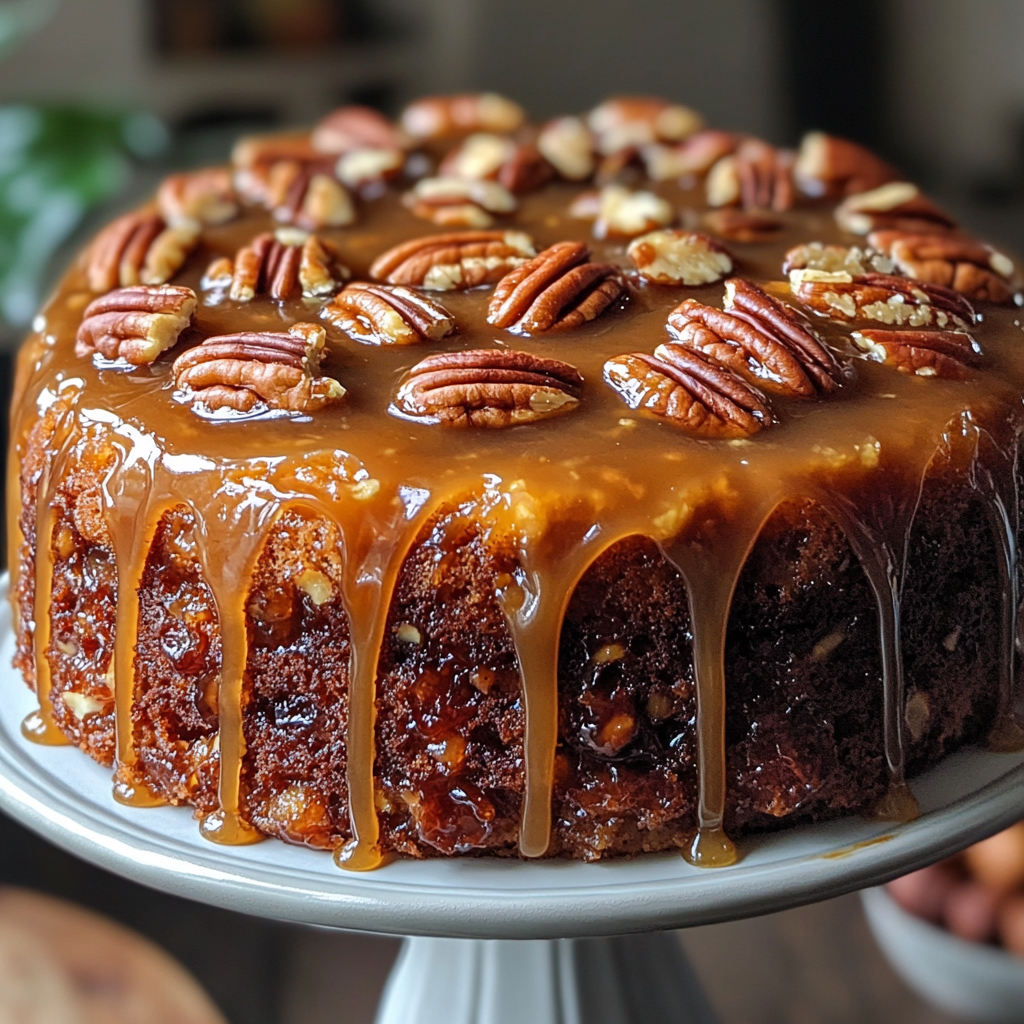
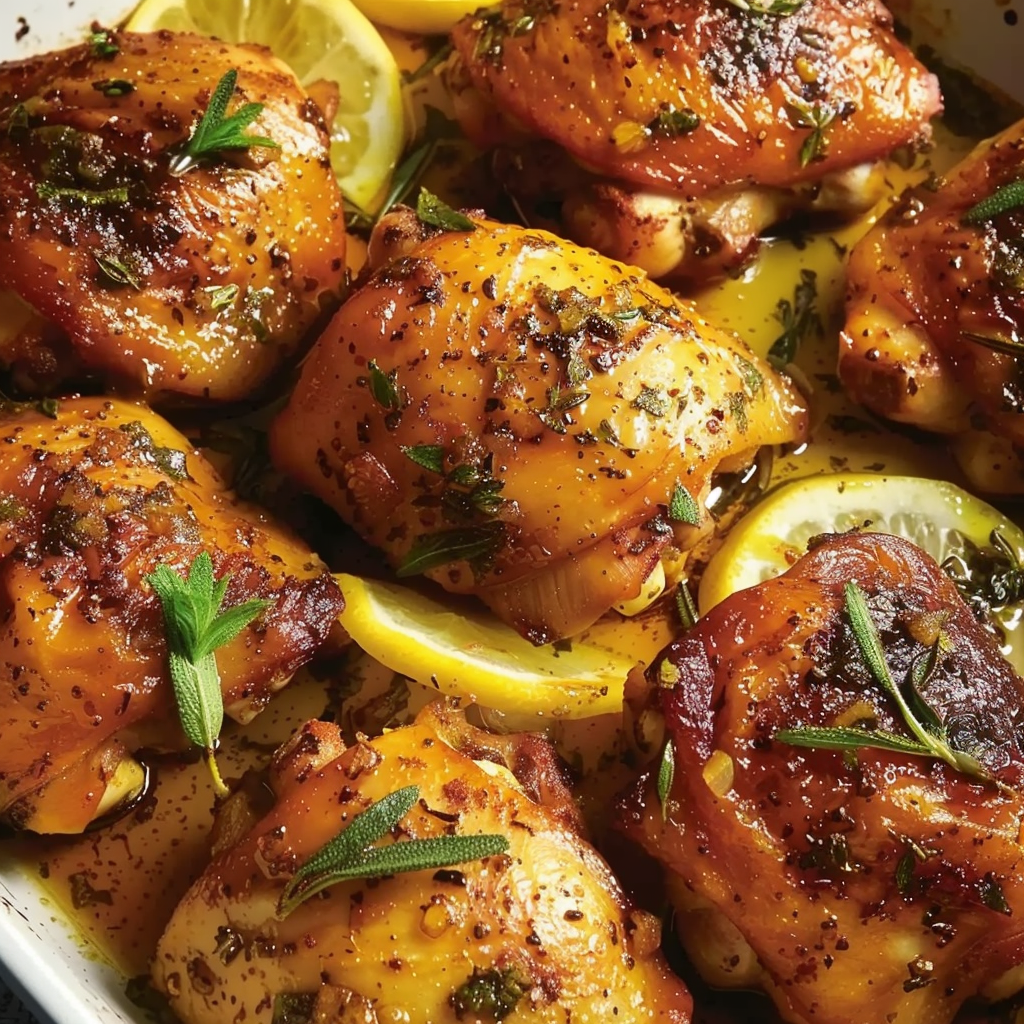
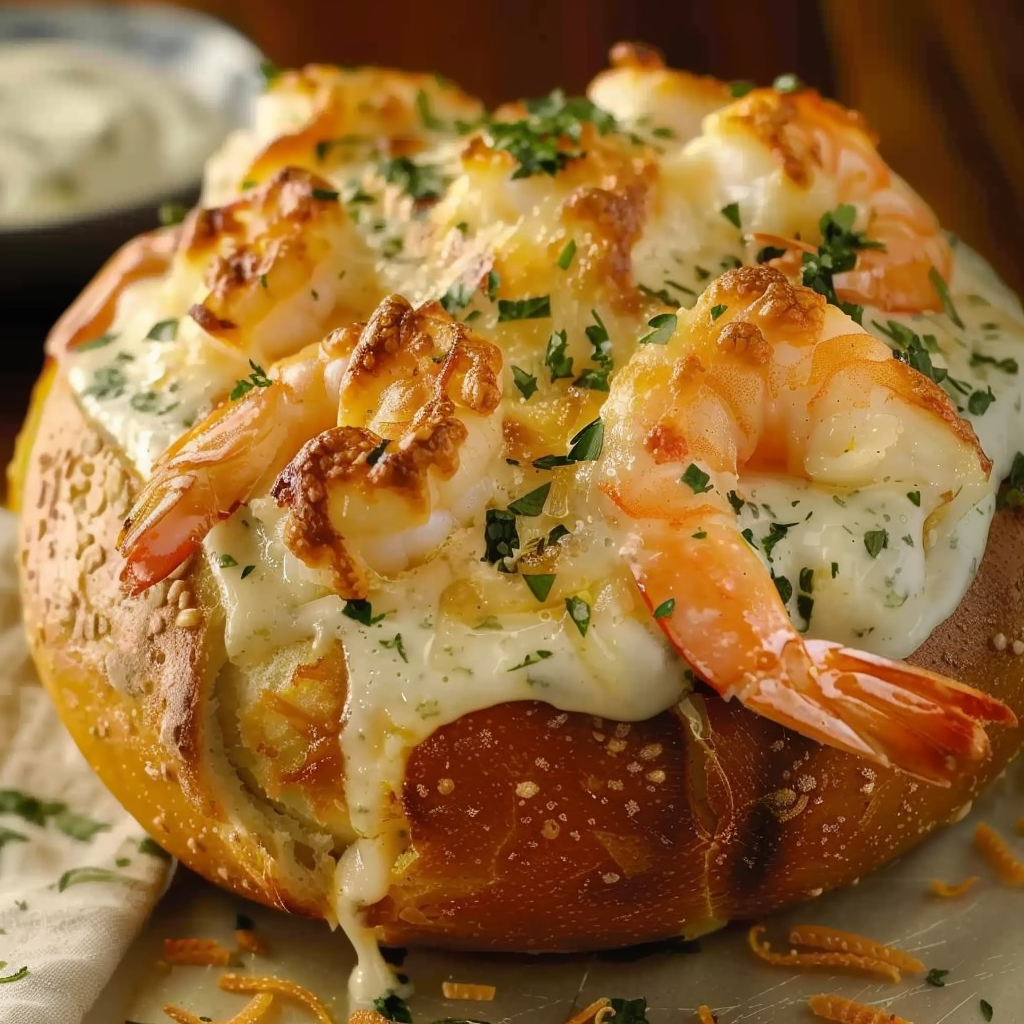
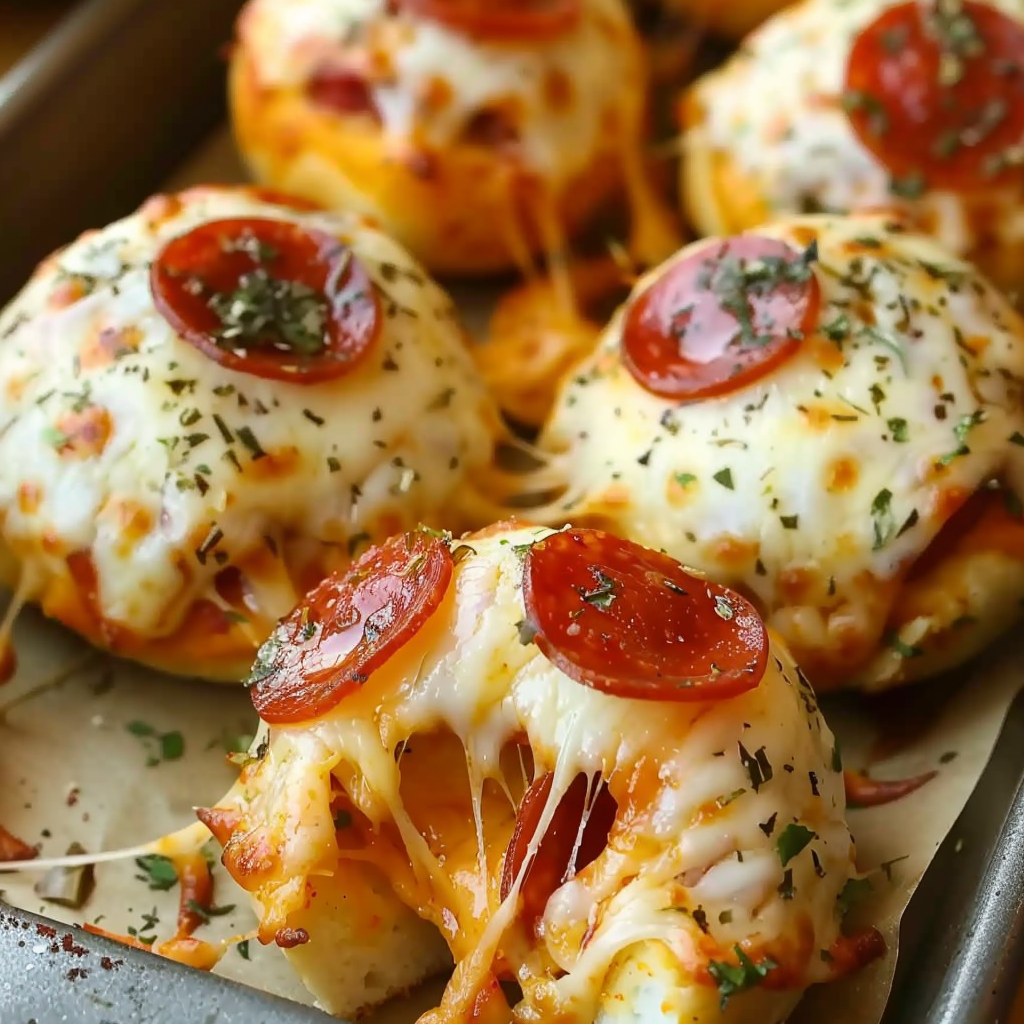


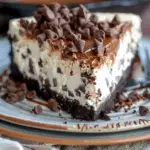
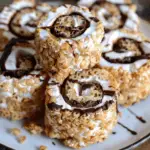
I followed the recipie to a T but the caramel ended up rock hard in the bottom of my bunt pan. Tastes good. But over all disappointing
★★★
Mine did the exact same thing. I had to scrape out the pan and put the nuts back on it. I don’t know what I did wrong.
★★★
the caramel ended up getting really hard and overcooked. I will try this again but make them caramel topping separate and drizzle on top after the cake it made
★★★
I’ve made this probably 5 times in the last couple months. EVERYONE loves it!! I used a Charlotte pan every time. Yes some of the brown sugar pecan mixture ends up stuck to the pan but it pulls off easily and is still delicious. I’m doing my first bunte cake today.
★★★★★
Hi, how would you adjust time and temp for a 4×8 fat daddio cake pan? It took1.5 hors to cook and the top was overcooked. Help!